Advertisement
Grab your lab coat. Let's get started
Welcome!
Welcome!
Create an account below to get 6 C&EN articles per month, receive newsletters and more - all free.
It seems this is your first time logging in online. Please enter the following information to continue.
As an ACS member you automatically get access to this site. All we need is few more details to create your reading experience.
Not you? Sign in with a different account.
Not you? Sign in with a different account.
ERROR 1
ERROR 1
ERROR 2
ERROR 2
ERROR 2
ERROR 2
ERROR 2
Password and Confirm password must match.
If you have an ACS member number, please enter it here so we can link this account to your membership. (optional)
ERROR 2
ACS values your privacy. By submitting your information, you are gaining access to C&EN and subscribing to our weekly newsletter. We use the information you provide to make your reading experience better, and we will never sell your data to third party members.
Policy
Funding For America Competes Act
Stimulus package directly allocates nearly $5.2 billion to physical science agencies key to U.S. competitiveness
by Rochelle F. H. Bohaty
March 2, 2009
| A version of this story appeared in
Volume 87, Issue 9

WHEN PRESIDENT Barack Obama committed $787 billion of taxpayers' money to stimulate the economy, he chose to sign the American Recovery & Reinvestment Act (ARRA) of 2009 at the Denver Museum of Nature & Science. The symbolic venue underscores Obama's commitment to boosting the economy through science and technology.
ARRA provides as much as $21.5 billion in federal research and development funding, according to estimates by the American Association for the Advancement of Science. Of that, almost $5.2 billion goes to the three science agencies identified for increased funding by the America Competes Act (ACA): the National Science Foundation, the National Institute of Standards & Technology (NIST), and the Department of Energy's Office of Science (DOE OS).
"Just as President Kennedy sparked an explosion of innovation when he set America's sights on the moon, I hope this investment will ignite our imagination once more, spurring new discoveries and breakthroughs in science, in medicine, in energy, to make our economy stronger and our nation more secure and our planet safer for our children," Obama said before signing ARRA on Feb. 17.

ACA aims to keep the U.S. globally competitive by boosting funding for science, technology, engineering, and mathematics research and education. Congress has still not provided the funding levels outlined in the law, which was passed in 2007 and would double the budgets of NSF, NIST, and DOE OS over a decade. The stimulus package changes that.
ARRA gives generously to the ACA-identified agencies to the tune of $3.0 billion for NSF, for a total 2009 estimated budget of $9.0 billion; $610 million for NIST, for an estimated budget of $1.3 billion; and $1.6 billion for DOE OS, for an estimated budget of $6.0 billion. This brings the budgets of these agencies above the levels approved in ACA.
With a 50% budget bump, NSF is slated to receive the largest budget increase of the three science agencies highlighted in ACA.
"The $3 billion provided to NSF will go directly into the hands of the nation's best and brightest researchers at the forefront of promising discoveries, to deserving graduate students at the start of their careers, and to developing advanced scientific tools and infrastructure that will be broadly available to the research community," NSF Director Arden L. Bement Jr. says.
The biggest chunk of this funding, approximately $2 billion, will go toward research proposals that may not have been funded because of budget constraints, deferred maintenance and capacity updates to fix existing facilities, and cyber infrastructure improvements.
Discussions held last week at a meeting of the National Science Board, NSF's governing committee, revealed further details about potential awards. Program managers will have the option to fund reviewed proposals from as far back as Oct. 1, 2008. Awards given will expire in a staggered fashion starting in 2012 to avoid a flood of grant applications that year. Additional expenditure reports will be required for these awards.
Of the remaining money allocated to NSF, $400 million will go to projects that have already been approved and passed through the final review stage for NSF's Major Research Equipment & Facilities Construction funds, $300 million will go to the Major Research Instrumentation Program, and $200 million will go to the Academic Research Infrastructure Program. And $100 million will go to education programs, including the Robert Noyce Teacher Scholarship, the Math & Science Partnership, and a new program to support professional science master's degrees.
NIST IS also working to flesh out the details of its plan for its share of the stimulus money. ARRA provides NIST with $580 million of direct funding in addition to transfers totaling $30 million from other agencies.
"With this funding we expect to create jobs and advance the U.S. science and technological infrastructure by building critically needed research facilities, expanding fellowships and research grants, and addressing important national priorities critical to our nation's future," says Patrick D. Gallagher, NIST's deputy director.
Direct funding allocated to NIST includes $220 million for laboratory research and $360 million for construction of research facilities. Half of this $360 million will be used for competitive construction grants, and the other half will go to internal NIST construction projects.
NIST will also receive a $20 million transfer from the Department of Health & Human Services to do standards-based research on the development of electronic medical records. And DOE will transfer $10 million to NIST to help develop the framework for a smart electrical power grid.
DOE is also hurrying to put together its ARRA plan. The agency will receive some $40 billion from the act. Of this, $1.6 billion will go to DOE OS.
Under consideration by DOE OS for funding with this money are major scientific facility construction projects already under way, important energy-related research investments, and national laboratory infrastructure modernization projects, according to DOE.
ARRA also provides $400 million to establish the Advanced Research Projects Agency for Energy (ARPA-E) within DOE. This agency was approved under ACA but never funded. ARPA-E will support transformational energy technology research projects with the goal of enhancing the nation's economic and energy security.
Like NIST and NSF, DOE is expected to release additional details soon. Agencies have just 60 days to submit a plan to Congress on how they will use their allocations. Agencies must also report how they'll spend their money on the website recovery.gov.
While agencies are scrambling to develop plans to spend their share of the stimulus package, scientific agencies and organizations such as the American Chemical Society are concerned over the ramifications of this one-time budget boost.
"To avoid a boom-and-bust scenario and to keep the U.S. on target to rebuild its economy, Congress and the Administration must keep the budgets of key agencies on a doubling trajectory in future appropriations bills," notes Glenn S. Ruskin, director of the Office of Public Affairs at ACS.




Join the conversation
Contact the reporter
Submit a Letter to the Editor for publication
Engage with us on Twitter